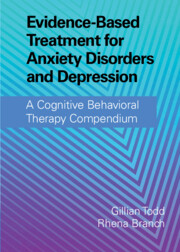 Evidence-Based Treatment for Anxiety Disorders and Depression
Evidence-Based Treatment for Anxiety Disorders and Depression Book contents
- Evidence-Based Treatment for Anxiety Disorders and Depression
- Evidence-Based Treatment for Anxiety Disorders and Depression
- Copyright page
- Contents
- Figures
- Tables
- Contributors
- 1 Introduction
- 2 The History and Philosophical Underpinnings of CBT:
- Part One Cognitive Behavioral Therapy for Anxiety Disorders
- Part Two Cognitive Behavioral Therapy for Posttraumatic Stress Disorder
- Part Three Cognitive Behavioral Therapy for Obsessive-Compulsive Disorder and Associated Disorders
- Part Four Cognitive Behavioral Therapy for Depression
- 18 Behavioral Activation
- 19 CBT for Persistent Depressive Disorder
- 20 Rumination-Focused Cognitive Behavioral Therapy
- 21 Cognitive Behavioral Therapy for Perinatal Depression
- Part Five Complexity and Comorbidity in Anxiety Disorders and Depression:
- Part Six Specialist Applications of Cognitive Behavioral Therapy for Anxiety Disorders and Depression
- Part Seven Future Developments
- Appendices
- Index
- References
19 - CBT for Persistent Depressive Disorder
from Part Four - Cognitive Behavioral Therapy for Depression
Published online by Cambridge University Press: 06 January 2022
- Evidence-Based Treatment for Anxiety Disorders and Depression
- Evidence-Based Treatment for Anxiety Disorders and Depression
- Copyright page
- Contents
- Figures
- Tables
- Contributors
- 1 Introduction
- 2 The History and Philosophical Underpinnings of CBT:
- Part One Cognitive Behavioral Therapy for Anxiety Disorders
- Part Two Cognitive Behavioral Therapy for Posttraumatic Stress Disorder
- Part Three Cognitive Behavioral Therapy for Obsessive-Compulsive Disorder and Associated Disorders
- Part Four Cognitive Behavioral Therapy for Depression
- 18 Behavioral Activation
- 19 CBT for Persistent Depressive Disorder
- 20 Rumination-Focused Cognitive Behavioral Therapy
- 21 Cognitive Behavioral Therapy for Perinatal Depression
- Part Five Complexity and Comorbidity in Anxiety Disorders and Depression:
- Part Six Specialist Applications of Cognitive Behavioral Therapy for Anxiety Disorders and Depression
- Part Seven Future Developments
- Appendices
- Index
- References
Summary
This chapter describes evidence-based cognitive behavioral therapy (CBT) for the treatment of persistent depressive disorder (PDD) based on an randomized controlled trial conducted in the Nottingham Mood Disorders Service in collaboration with the University of Nottingham, UK. The chapter identifies three key challenges in the context of persistent depression. A case example is used to illustrate the treatment model and the implementation of a collaboratively derived psycho-bio-social formulation and its associated cognitive behavioral interventions.
Keywords
- Type
- Chapter
- Information
- Evidence-Based Treatment for Anxiety Disorders and DepressionA Cognitive Behavioral Therapy Compendium, pp. 383 - 401Publisher: Cambridge University PressPrint publication year: 2022


